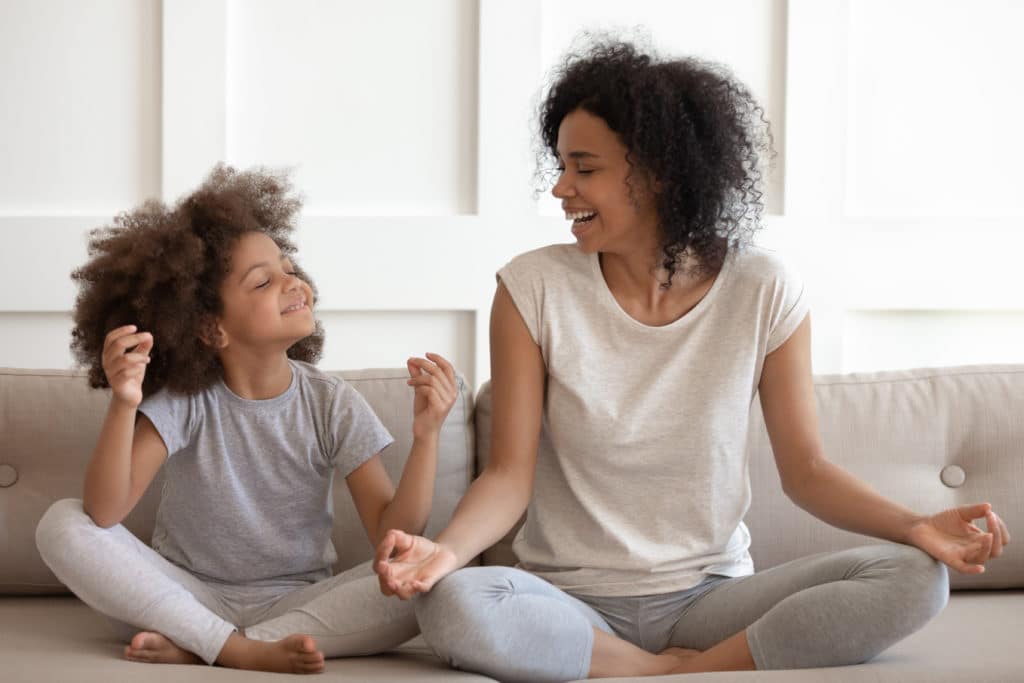Added thoughts, feelings, and stressors on our mind typically have a direct correlation with our related mood and associated behaviors, which can impact our daily lives and functioning abilities. Mental health disorders among children are described as serious changes in the way children typically learn, behave, or handle their emotions, which cause distress and problems getting through the day.
Children of all ages can benefit from mindfulness, the simple practice of bringing a gentle, accepting attitude to the present moment. This practice can also help parents and caregivers, too, by promoting joy, stimulation, and relieving stress.
The beautiful thing about mindfulness practice is there is flexibility to seek the best calming and regulating strategies for that individual. There is not just one specific mindfulness tool, yet a global spectrum of available opportunities to connect with your mind and body to promote a calm internal environment.
To better breakdown this concept, mindfulness practice can be defined as a moment-to-moment awareness of one’s experience without judgment. It can be promoted by certain practices or activities, such as deep breathing, meditation, or bodily and sensory awareness. There are endless ways to cultivate and practice mindfulness. The goal of any mindfulness technique is typically to achieve a state of alert, focused relaxation. That’s accomplished by deliberately paying attention to emotions, thoughts, and sensations to enable the mind to refocus on the present moment.
Some key points to observe and attempt to be internally aware of during a mindfulness practice include:
- Body Sensations
- Notice body sensations, such as tingling, pulsing, or even no feeling, and allow some exploration of the sensation. Pay attention to each part of your body in succession from head to toe.
- Sensory
- Detect sights, sounds, smells, tastes, and touches, and then let them stay in your awareness as long as you would like without judgment. When the mind begins to stray from the immediate sensation, bring your attention back to your choice of focus.
- Emotions
- Allow emotions to be present. Practice a steady and relaxed naming of emotions: “joy,” “anger,” “frustration.” Accept their presence and let them go.
The Center for Disease Control and Prevention (CDC) notes the most common mental health disorders in children and adolescents are anxiety, depression, mood disorders, and attention deficit hyperactivity disorder (ADHD).
Often, anxiety and depressive symptomatology, as well as other mental health disorders, manifest in young children through behavioral responses, actions, and verbal and emotional expressions. Prior to implementing the art of mindfulness practice, it is important to know what signs and symptoms to look for in children, to better understand their mindset and related needs.
Anxiety may present as fear or worry but can also make children irritable and angry. Anxiety symptoms can also include trouble sleeping, as well as physical symptoms, such as fatigue, headaches, or stomachaches. Some anxious children keep their worries to themselves and, thus, the symptoms can be harder to pinpoint.
Depression might also cause a child to make trouble or act unmotivated, causing others not to notice that the child is depressed or to incorrectly label the child as a ‘trouble-maker’ or ‘lazy.’
By incorporating mindfulness practice into our lives, we give ourselves the opportunity to release the thoughts on our mind and connect with our bodies. Mindfulness practice is the art and ability to focus on being aware of what you are sensing and feeling in the given moment.
Mental health, including the practice of mindfulness meditation, is an important part of children’s overall health and well-being. Mental health includes children’s mental, emotional, and behavioral well-being. It affects how children think, feel, and act. It also plays a role in how children handle stress, relate to others, and make healthy choices.
So, let’s talk about how to shake those thoughts from our full minds to promote mindfulness practice!
Here are three helpful starting tips to introduce mindfulness techniques into your child’s life:
- Deep Breathing Exercises – Sometimes it can be helpful to reference a guide while focusing on the inhalation and exhalation. Try practicing with your hand, an image of a star, or square – Guide your finger while tracing your hand, a star, or square. Take a deep breath in with one trace of the finger, followed by an exhale out. The art of diaphragmatic breathing can be helpful to regulate the mind and body!
- Hand/Finger Breathing
- Star Breathing
- Square Breathing
- Mindfulness drawing or coloring – Mindful connection with the act of art and drawing can result in a deeper sense of well-being. Try focusing your attention to the art activity at hand. Five minutes of focused uninterrupted mindfulness drawing can help to relax the mind and body.

- Body Scanning – Body Scanning involves focusing your attention to parts of your body and the internal bodily sensations in a gradual sequence as you scan from your head to your feed. This art of mentally scanning your body helps to promote awareness to every part of your body.

Mindfulness activities help to create a sense of physical and mental calm that allows one to pause, reflect, and focus on the present. Studies have shown that mindfulness practice promotes benefits not only for one’s mental health but also for the person’s physical well-being. I challenge you and your child to carve out 5 minutes daily for mindfulness practice. Together, let’s un-fill our minds with stressful thoughts and fill it with the art of mindfulness!
It is important to recognize that although these activities may help reduce the residual effects of stress, there may be more that your child needs. Should you have any further questions about your child’s emotional needs, please send us an email at [email protected] or use the “Ask the therapist” option on our website.
References:
- American Psychiatric Association: Diagnostic and Statistical Manual of Mental Disorders, 5th edition. Arlington, VA., American Psychiatric Association, 2013
- Center for Disease Control and Prevention (2021, March 22). Anxiety and Depression in Children. Retrieved from https://www.cdc.gov/childrensmentalhealth/depression.html#anxiety
- Bertin, M. (2016, October 16). Body Scan for Kids. Daily Practices. Retrieved from https://www.mindful.org/body-scan-kids/
- Sound It Out Together: Caregivers Guide to Stress. 2022. Retrieved from https://sounditouttogether.org/guides/emotion/stress/?gclid=Cj0KCQjwjN-SBhCkARIsACsrBz6x5pc8qfZxeE3QQkjHdu6yAWXLLDtso6AfpkTEIyWQkSAmATRIMAEaApV-EALw_wcB
- Miles for Migraine: The Mind-Body Connection. 2022. Retrieved from https://www.milesformigraine.org/the-mind-body-connection-managing-migraine/?gclid=CjwKCAjw9-KTBhBcEiwAr19ig_L6hLxEV3hEkfFQRZon5mbQIIUmxtf1Cx7T4Bv_OraIVGeDlg-jRRoCg5kQAvD_BwE
- David Gelles. Mindfulness for Children. The New York Times Publication. 2022. Retrieved from https://www.nytimes.com/guides/well/mindfulness-for-children

